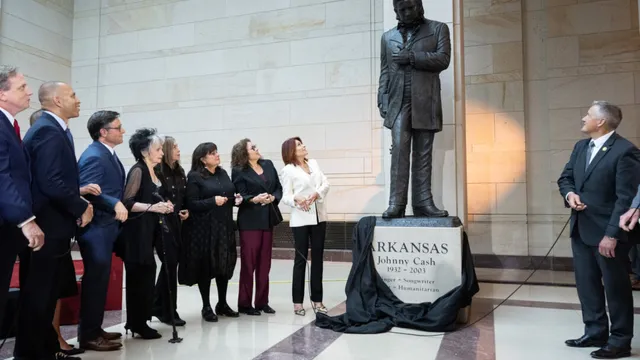
Johnny Cash statue unveiled in US Capitol's Emancipation Hall
2024-09-27 03:02- A bronze statue of Johnny Cash was unveiled in Emancipation Hall at the U.S. Capitol on September 24.
- The statue replaces a likeness of former U.S. Senator James Paul Clarke, a segregationist, reflecting a shift in Arkansas's representation.
- This historic honor marks Cash as the first musician to receive a statue in the U.S. Capitol, celebrating his legacy and connection to the American spirit.
Express your sentiment!
Insights
On September 24, 2023, a bronze statue of Johnny Cash was unveiled in Emancipation Hall at the U.S. Capitol, marking a significant milestone in American history. The event was attended by congressional leaders, Arkansas officials, and over 100 family members, including his daughters and sister. This statue replaces the likeness of James Paul Clarke, a former U.S. Senator and segregationist, highlighting a shift in the values represented in the Capitol. The decision to honor Cash, who was born in Arkansas, reflects a broader change in societal values and recognition of individuals who embody the American spirit. Arkansas Governor Asa Hutchinson emphasized the need for change, noting that the previous statues did not represent the current ideals of the state. The unveiling of Cash's statue is part of a larger initiative to replace outdated representations with figures who better reflect contemporary values. Cash's statue depicts him in a thoughtful pose, holding a Bible and gripping his guitar strap, symbolizing his deep connection to music and faith. This honor not only celebrates his contributions to music but also acknowledges his impact on American culture and society. As the first musician to be commemorated with a statue in the U.S. Capitol, Cash's legacy is solidified, inspiring future generations to appreciate the significance of his work and the values he represented throughout his life and career.
Contexts
The U.S. Capitol, a symbol of democracy, houses a remarkable collection of statues that tell the story of the nation’s history and values. The concept of a National Statuary Hall emerged in the mid-19th century, coinciding with the expansion of the Capitol building. As the House of Representatives moved into a larger chamber in 1857, the old chamber transformed into a space for honoring notable figures from each state. The proposal to create a National Statuary Hall became law on July 2, 1864, and by 1870, the first statue was placed, marking the beginning of a tradition that would see all 50 states contribute their own representations by 1971. Over the years, the collection has evolved, reflecting the changing values and narratives of American society. In 1976, a significant rearrangement of the statues took place to alleviate crowding, with statues organized by height and material. This effort not only improved the aesthetic appeal of the Hall but also highlighted the contributions of the original colonies, which were prominently displayed in the Central Hall of the East Front Extension. The statues serve as a reminder of the diverse history and heritage of the United States. In recent years, the Capitol has seen a shift towards inclusivity, with states replacing statues that no longer align with contemporary values. For instance, Alabama replaced its statue of Jabez Curry with one of Helen Keller in 2009, and Virginia removed the statue of Robert E. Lee in 2020, replacing it with Barbara Rose Johns Powell. These changes signify a broader recognition of civil rights and the contributions of marginalized figures in American history. The ongoing evolution of the National Statuary Hall reflects a nation in progress, continually reassessing its past while honoring the ideals of liberty and justice for all. As new statues are unveiled, they not only commemorate individual achievements but also inspire future generations to strive for a more inclusive and equitable society.